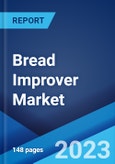The global bread improver market size reached US$ 3.8 Billion in 2023. Looking forward, the market is expected to reach US$ 6.1 Billion by 2032, exhibiting a growth rate (CAGR) of 5.4% during 2023-2032.
Also known as dough conditioners, bread improvers are food additives comprising oxidizing and reducing agents, enzymes, emulsifiers, and soya flour. They activate the gluten, alleviate the baking process and enhance functionality properties. They assist in improving the texture, color, taste, composition and tenderness of the bread. They also help reduce wastage, improve workability, maintain a strong structure and provide better volume. As they ensure faster leaving and have a longer shelf life, the demand for bread improvers is escalating around the world.
These product variants are also gaining traction in quick-service restaurants (QSRs) worldwide. This, in confluence with a significant increase in the consumption of ready-to-eat (RTE) food products, is strengthening the market growth. Furthermore, bread manufacturers are focusing on investing in research and development (R&D) activities to introduce innovative product variants, which is creating a favorable market outlook. Other major factors, including sedentary lifestyles, inflating income levels and the introduction of organic bread improvers, are anticipated to drive the market.
Also known as dough conditioners, bread improvers are food additives comprising oxidizing and reducing agents, enzymes, emulsifiers, and soya flour. They activate the gluten, alleviate the baking process and enhance functionality properties. They assist in improving the texture, color, taste, composition and tenderness of the bread. They also help reduce wastage, improve workability, maintain a strong structure and provide better volume. As they ensure faster leaving and have a longer shelf life, the demand for bread improvers is escalating around the world.
Bread Improver Market Trends:
Bread improvers play a pivotal role in keeping bread fresh and soft. As a result, there is a considerable rise in the utilization of bread improvers in the baking industry across the globe. This can be accredited to their benefits like easing the complex process of baking and reducing the use of other ingredients like salt and cysteine. Apart from this, increasing consumption of bread and bread products is also positively influencing the overall sales. Moreover, rising awareness about health among individuals is catalyzing the demand for baked food products, such as whole wheat and multigrain bread, which are healthier and provide more value and variety.These product variants are also gaining traction in quick-service restaurants (QSRs) worldwide. This, in confluence with a significant increase in the consumption of ready-to-eat (RTE) food products, is strengthening the market growth. Furthermore, bread manufacturers are focusing on investing in research and development (R&D) activities to introduce innovative product variants, which is creating a favorable market outlook. Other major factors, including sedentary lifestyles, inflating income levels and the introduction of organic bread improvers, are anticipated to drive the market.
Key Market Segmentation:
The publisher provides an analysis of the key trends in each sub-segment of the global bread improver market report, along with forecasts at the global, regional and country level from 2024-2032. Our report has categorized the market based on type, form, and application.Breakup by Type:
- Organic
- Inorganic
Breakup by Form:
- Powder
- Liquid
- Paste
Breakup by Application:
- Bread
- Cakes
- Viennoiserie
- Others
Breakup by Region:
- North America
- United States
- Canada
- Asia-Pacific
- China
- Japan
- India
- South Korea
- Australia
- Indonesia
- Others
- Europe
- Germany
- France
- United Kingdom
- Italy
- Spain
- Russia
- Others
- Latin America
- Brazil
- Mexico
- Others
- Middle East and Africa
Competitive Landscape:
The competitive landscape of the industry has also been examined along with the profiles of the key players being Archer Daniels Midland Company, Associated British Foods plc, Bakels Sweden AB, Corbion N.V., DuPont de Nemours Inc., Ireks GmbH, Koninklijke DSM N.V., Lesaffre, Oriental Yeast Co. Ltd. (Nisshin Seifun Group Inc.), Oy Karl Fazer Ab, Puratos Group, and Riken Vitamin Co. Ltd.Key Questions Answered in This Report:
- How has the global bread improver market performed so far and how will it perform in the coming years?
- What has been the impact of COVID-19 on the global bread improver market?
- What are the key regional markets?
- What is the breakup of the market based on the type?
- What is the breakup of the market based on the form?
- What is the breakup of the market based on the application?
- What are the various stages in the value chain of the industry?
- What are the key driving factors and challenges in the industry?
- What is the structure of the global bread improver market and who are the key players?
- What is the degree of competition in the industry?
Table of Contents
1 Preface3 Executive Summary11 Value Chain Analysis13 Price Analysis
2 Scope and Methodology
4 Introduction
5 Global Bread Improver Market
6 Market Breakup by Type
7 Market Breakup by Form
8 Market Breakup by Application
9 Market Breakup by Region
10 SWOT Analysis
12 Porters Five Forces Analysis
14 Competitive Landscape
List of Figures
List of Tables
Companies Mentioned
- Archer Daniels Midland Company
- Associated British Foods plc
- Bakels Sweden AB
- Corbion N.V.
- DuPont de Nemours Inc.
- Ireks GmbH
- Koninklijke DSM N.V.
- Lesaffre
- Oriental Yeast Co. Ltd. (Nisshin Seifun Group Inc.)
- Oy Karl Fazer Ab
- Puratos Group
- Riken Vitamin Co. Ltd.
Methodology

LOADING...
Table Information
| Report Attribute | Details |
|---|---|
| No. of Pages | 140 |
| Published | August 2024 |
| Forecast Period | 2023 - 2032 |
| Estimated Market Value ( USD | $ 3.8 Billion |
| Forecasted Market Value ( USD | $ 6.1 Billion |
| Compound Annual Growth Rate | 5.4% |
| Regions Covered | Global |
| No. of Companies Mentioned | 12 |









